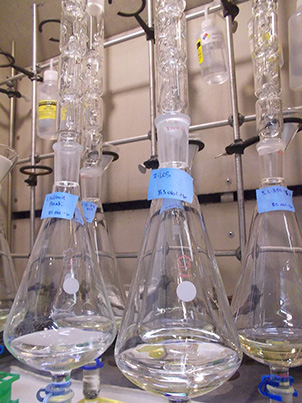Summary
The OSPR Laboratory Program (OLP) provides consultation and data to support enforcement, monitoring, investigative, and research activities initiated by our Agency, Agency partners, or non-profit research organizations. Quality assurance systems have been implemented in OLP labs to ensure:

- Sample chain-of-custody
- Sample integrity
- Data quality
- Technical soundness and consistency
- Data traceability
However, the responsibility for high quality data is shared by the laboratory and its clients. Because laboratory methods and data reporting are not standardized across the industry, it is critical that clients take the time to communicate with the labs about their project requirements. Early communication will help ensure that:
- Analytes are relevant to the client
- Reporting limits will meet client needs
- Desired quality controls are reported
- Methods are validated
- The lab includes elements in the final report needed to allow objective assessment of the data
Certification
We are certified by California’s Environmental Laboratory Accreditation Program (Cal EPA Division of Drinking Water, Certificate 1622) to perform inorganics analyses in support of CDFW hatchery NPDES permits.
Sample Chain-of-Custody
Samples must be submitted to the lab with a chain-of-custody form that identifies the sample, project, submitter, and requested tests. Laboratory chain-of-custody begins after samples are inspected, inventoried against the submitted chain-of-custody form, and tagged with a laboratory tracking number by sample receiving personnel. The laboratory tracking number is used to identify the sample during secured storage and as it is processed by the laboratory. The laboratory assumes official custody of the samples after signing the chain-of-custody form. For guidance in correctly completing a chain-of-custody form please contact OLP staff.
Sample Integrity
Quality data begins with the proper collection and timely transport of a representative sample from the location of interest. Pre-cleaned containers, and/or certified-clean and lot-traceable containers are provided upon request to avoid contamination or analyte loss that may occur from the use of inappropriate containers. Depending on the analyte of interest, sample preservatives may be added in accordance with US EPA 40CFR Part 136 requirements. Once the lab assumes custody of the samples, samples are stored in a manner to minimize access from unauthorized personnel and to further delay analyte degradation. Contact OSPR lab staff to obtain more information or to order pre-cleaned containers.
Data Quality
Samples are processed in batches defined by method, matrix, reagents, and frequency. Every batch includes quality controls that provide the lab and data user with a measure of the contamination introduced by lab processes, analyte recovery in a control matrix, bias imparted by the field matrix on analyte recovery, precision of the process, sample homogeneity, and equipment fitness. Laboratory processes are not infallible and quality controls also provide the lab and data user with indicators of bias or unsuitability for use. All data are reported with batch quality controls and when necessary, data qualifiers. For assistance with lab reports and data, contact the OSPR laboratory staff listed below.
Technical Soundness and Consistency
Methods must be validated prior to use on samples. Validation includes determination of minimum detection limits, reporting limits, analyte recovery in a control matrix, and definition of the identifiers to unambiguously identify the analyte under controlled laboratory conditions. Routine, validated procedures are documented in standard operating procedures accessible only to OSPR lab personnel. OSPR labs, as applicable, participate in single-blind round-robin inter-laboratory performance evaluations. Annually, OSPR lab personnel must sign an ethics statement attesting to personal responsibility for data integrity and scientific conduct.
Data Traceability
Reports and raw data include sufficient information to allow re-creation of a result from sample receipt to the reference standard used to calibrate equipment. Hard copy reports may be retrievable up to 7 years after sample submission.